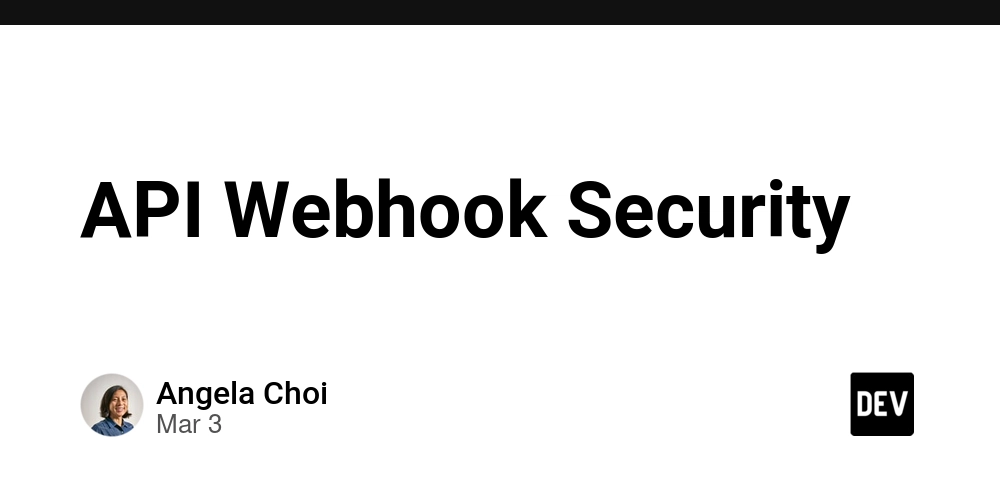API Webhook Security
I believe that sharing information about web security is essential so that individuals can learn to secure their web applications and APIs. I will document my journey in web security and API security. Recently, I've been working with webhooks, where security remains my top priority. Here are some tips to keep your webhooks safe: 1. Strict validation of the webhook URL The main vulnerability in webhook services is server-side request forgery (SSRF), where an attacker tricks your service into making unintended requests within your network. Webhooks are especially vulnerable because users provide a URL for your application to send a request. This can result in leaking private information or triggering internal actions for the attacker. Validating allowed URLs helps users by quickly informing them when their input is incompatible with your webhook service. 2. Use Hash-Based Message Authentication Code (HMAC) To verify webhook requests, it's essential to confirm that the information hasn’t been altered, as even encrypted messages can be intercepted. Signature verification is a reliable method to ensure message integrity. The webhook provider sends a message along with a signature generated using the HMAC algorithm. Upon receiving the message, the client generates its signature using HMAC. If the signatures match, the message is considered valid. If they do not, the message may have been tampered with and should be rejected. For example, Stripe includes the signature in a header called Stripe-Signature in its webhook requests. 3. Timeouts and Retries Set timeouts for webhook requests. If a request isn’t completed within the expected timeframe, either reject or retry the request. Implement retry mechanisms to handle temporary failures, ensuring the system remains secure against data loss. 4. Logging and Monitoring Log all incoming webhook requests, including timestamps, IP addresses, and payload content (excluding sensitive information). Set up monitoring for unusual or suspicious activity, such as a sudden spike in requests, to detect potential attacks or misuse. 5. Authorization Ensure that only the user who subscribed to a webhook can access that particular subscription and that users do not have access to others' webhook subscriptions. Always verify the user's access privileges to confirm their permission to trigger specific webhook actions. By keeping these tips in mind, you can significantly enhance the security of your webhooks.

I believe that sharing information about web security is essential so that individuals can learn to secure their web applications and APIs. I will document my journey in web security and API security. Recently, I've been working with webhooks, where security remains my top priority.
Here are some tips to keep your webhooks safe:
1. Strict validation of the webhook URL
The main vulnerability in webhook services is server-side request forgery (SSRF), where an attacker tricks your service into making unintended requests within your network. Webhooks are especially vulnerable because users provide a URL for your application to send a request. This can result in leaking private information or triggering internal actions for the attacker. Validating allowed URLs helps users by quickly informing them when their input is incompatible with your webhook service.
2. Use Hash-Based Message Authentication Code (HMAC)
To verify webhook requests, it's essential to confirm that the information hasn’t been altered, as even encrypted messages can be intercepted. Signature verification is a reliable method to ensure message integrity. The webhook provider sends a message along with a signature generated using the HMAC algorithm. Upon receiving the message, the client generates its signature using HMAC.
If the signatures match, the message is considered valid. If they do not, the message may have been tampered with and should be rejected. For example, Stripe includes the signature in a header called Stripe-Signature in its webhook requests.
3. Timeouts and Retries
Set timeouts for webhook requests. If a request isn’t completed within the expected timeframe, either reject or retry the request. Implement retry mechanisms to handle temporary failures, ensuring the system remains secure against data loss.
4. Logging and Monitoring
Log all incoming webhook requests, including timestamps, IP addresses, and payload content (excluding sensitive information). Set up monitoring for unusual or suspicious activity, such as a sudden spike in requests, to detect potential attacks or misuse.
5. Authorization
Ensure that only the user who subscribed to a webhook can access that particular subscription and that users do not have access to others' webhook subscriptions. Always verify the user's access privileges to confirm their permission to trigger specific webhook actions.
By keeping these tips in mind, you can significantly enhance the security of your webhooks.











































































































































































![[The AI Show Episode 142]: ChatGPT’s New Image Generator, Studio Ghibli Craze and Backlash, Gemini 2.5, OpenAI Academy, 4o Updates, Vibe Marketing & xAI Acquires X](https://www.marketingaiinstitute.com/hubfs/ep%20142%20cover.png)




























































































































![[DEALS] The Premium Learn to Code Certification Bundle (97% off) & Other Deals Up To 98% Off – Offers End Soon!](https://www.javacodegeeks.com/wp-content/uploads/2012/12/jcg-logo.jpg)


![From drop-out to software architect with Jason Lengstorf [Podcast #167]](https://cdn.hashnode.com/res/hashnode/image/upload/v1743796461357/f3d19cd7-e6f5-4d7c-8bfc-eb974bc8da68.png?#)








































































































.png?#)

































_Christophe_Coat_Alamy.jpg?#)
 (1).webp?#)





































































































![Apple Considers Delaying Smart Home Hub Until 2026 [Gurman]](https://www.iclarified.com/images/news/96946/96946/96946-640.jpg)
![iPhone 17 Pro Won't Feature Two-Toned Back [Gurman]](https://www.iclarified.com/images/news/96944/96944/96944-640.jpg)
![Tariffs Threaten Apple's $999 iPhone Price Point in the U.S. [Gurman]](https://www.iclarified.com/images/news/96943/96943/96943-640.jpg)




































































































































